Virtual concerts are live musical performances conducted in a digital environment, allowing audiences to participate remotely through streaming technology. This article explores the rise of virtual concerts, particularly during the COVID-19 pandemic, highlighting their differences from traditional concerts, the technologies that enable them, and their growing popularity as a means of music discovery. Key features such as interactive audience engagement and immersive experiences are discussed, along with the challenges faced in monetization and technical execution. Additionally, the article examines how virtual concerts facilitate music discovery and promote new artists, emphasizing the role of social media and algorithms in enhancing audience engagement and visibility.
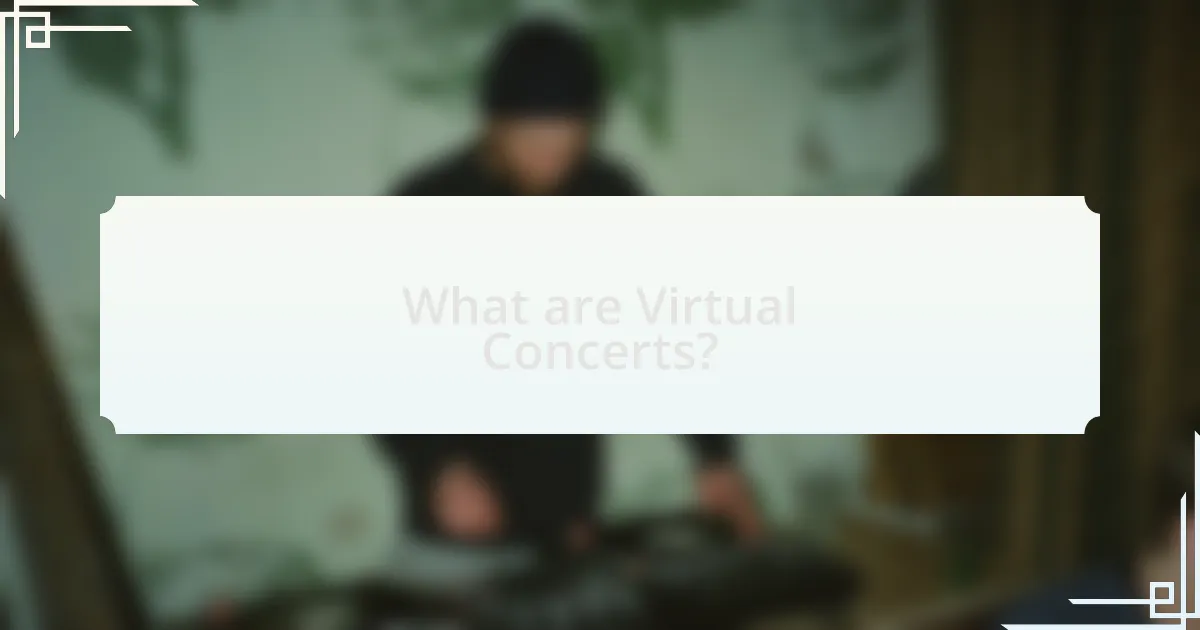
What are Virtual Concerts?
Virtual concerts are live musical performances that take place in a digital environment, allowing audiences to experience the event remotely via streaming technology. These concerts can be accessed through various platforms, enabling artists to reach global audiences without the constraints of physical venues. The rise of virtual concerts has been significantly influenced by advancements in technology and the need for alternative performance methods, especially during events like the COVID-19 pandemic, which limited in-person gatherings. According to a report by Pollstar, the virtual concert market saw a substantial increase in participation, with millions of viewers tuning in to performances, highlighting their growing importance in music discovery and fan engagement.
How do Virtual Concerts differ from Traditional Concerts?
Virtual concerts differ from traditional concerts primarily in their format and accessibility. Virtual concerts are conducted online, allowing audiences to participate from anywhere with an internet connection, while traditional concerts require physical attendance at a specific venue. This shift to a digital platform enables a broader reach, as evidenced by the fact that during the COVID-19 pandemic, platforms like YouTube and Twitch saw significant increases in viewership for virtual events, with some artists reaching millions of viewers globally. Additionally, virtual concerts often incorporate interactive elements, such as live chats and social media integration, enhancing audience engagement compared to the more passive experience of traditional concerts.
What technologies enable Virtual Concerts?
Virtual concerts are enabled by several key technologies, including streaming platforms, virtual reality (VR), augmented reality (AR), and interactive software. Streaming platforms like YouTube and Twitch facilitate live broadcasts, allowing artists to reach global audiences in real-time. Virtual reality technology immerses users in a 3D environment, creating an engaging concert experience, while augmented reality enhances live performances with digital overlays. Interactive software enables audience participation through chat features and virtual meet-and-greets, enhancing the overall experience. These technologies collectively transform how concerts are experienced, making them accessible and engaging for a wider audience.
What are the key features of Virtual Concerts?
Virtual concerts primarily feature live streaming performances, interactive audience engagement, and immersive experiences through augmented or virtual reality. Live streaming allows artists to reach global audiences in real-time, breaking geographical barriers. Interactive audience engagement includes chat functions, virtual meet-and-greets, and social media integration, enhancing the connection between performers and fans. Immersive experiences, often facilitated by technology, provide unique visual and auditory elements that can replicate or enhance the live concert atmosphere. These features collectively contribute to the growing popularity of virtual concerts, especially during events like the COVID-19 pandemic, where traditional gatherings were restricted.
Why have Virtual Concerts gained popularity?
Virtual concerts have gained popularity due to their accessibility and the ability to reach a global audience. Unlike traditional concerts, virtual events eliminate geographical barriers, allowing fans from different locations to participate without travel costs or venue limitations. For instance, during the COVID-19 pandemic, platforms like YouTube and Twitch reported significant increases in viewership, with some artists attracting millions of viewers for single performances. This shift has also been supported by advancements in streaming technology, which enhance the viewing experience, making it more engaging and interactive for audiences.
What role did the COVID-19 pandemic play in this rise?
The COVID-19 pandemic significantly accelerated the rise of virtual concerts as a primary means for artists to connect with audiences. With physical venues closed and social distancing measures in place, musicians turned to online platforms to perform live shows, leading to a surge in virtual concert attendance. For instance, a report by Pollstar indicated that virtual concerts generated over $100 million in revenue in 2020, highlighting their financial viability. This shift not only provided artists with a new revenue stream but also expanded their reach to global audiences, facilitating music discovery in ways that traditional concerts could not.
How do social media and streaming platforms contribute to their growth?
Social media and streaming platforms significantly contribute to the growth of virtual concerts by enhancing audience reach and engagement. These platforms allow artists to promote their events to a global audience, facilitating access to diverse fan bases. For instance, platforms like Instagram and TikTok enable artists to share snippets of their performances, generating buzz and anticipation. Additionally, streaming services such as Spotify and YouTube provide analytics that help artists understand listener preferences, allowing for tailored content that resonates with audiences. According to a report by the International Music Summit, the global live music market is projected to reach $30 billion by 2025, largely driven by the integration of social media and streaming technologies in promoting virtual events.
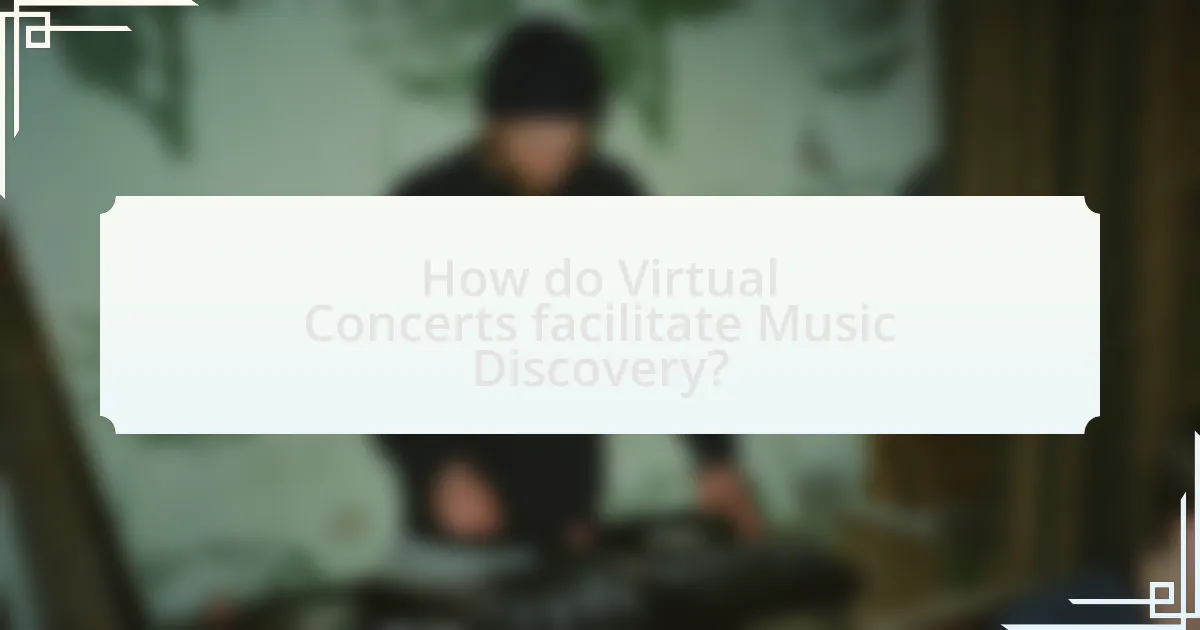
How do Virtual Concerts facilitate Music Discovery?
Virtual concerts facilitate music discovery by providing access to a diverse range of artists and genres in an interactive online environment. These events often feature multiple performers, allowing audiences to explore new music that they may not encounter in traditional concert settings. For instance, platforms like YouTube and Twitch host virtual concerts that attract millions of viewers, exposing them to emerging artists and niche genres. Additionally, algorithms on streaming services often recommend similar artists based on user engagement during these virtual events, further enhancing the discovery process. This combination of exposure and algorithmic recommendations significantly broadens listeners’ musical horizons.
What are the mechanisms through which Virtual Concerts promote new artists?
Virtual concerts promote new artists primarily through increased accessibility, audience engagement, and social media amplification. Increased accessibility allows artists to reach global audiences without geographical limitations, enabling them to perform for fans who may not have been able to attend live events. Audience engagement during virtual concerts often includes interactive features such as live chats and Q&A sessions, which foster a sense of community and connection between artists and fans. Social media amplification occurs when viewers share their experiences and promote the concert on various platforms, leading to organic exposure for the artists. For instance, a study by the International Music Summit in 2021 highlighted that virtual events increased audience reach by up to 300%, demonstrating the effectiveness of these mechanisms in promoting new talent.
How do algorithms and recommendations work in the context of Virtual Concerts?
Algorithms and recommendations in the context of virtual concerts analyze user data to personalize the viewing experience. These algorithms utilize machine learning techniques to assess user preferences, such as past concert attendance, music genre interests, and engagement metrics. By processing this data, platforms can suggest relevant virtual concerts that align with individual tastes, thereby enhancing user satisfaction and retention. For instance, a study by Spotify revealed that personalized playlists significantly increase user engagement, demonstrating the effectiveness of tailored recommendations in music-related contexts.
What role do collaborations play in music discovery during Virtual Concerts?
Collaborations significantly enhance music discovery during virtual concerts by introducing diverse musical styles and audiences. When artists collaborate, they often merge their fan bases, allowing listeners to explore new genres and artists they may not have encountered otherwise. For instance, a study by the International Journal of Music Business Research found that collaborative performances can increase audience engagement by up to 30%, as fans are drawn to the unique combinations of talent. This cross-pollination of audiences fosters a broader appreciation for different musical expressions, ultimately facilitating greater music discovery in the virtual concert space.
How do audiences engage with music during Virtual Concerts?
Audiences engage with music during virtual concerts primarily through interactive features such as live chats, reactions, and social media sharing. These platforms allow viewers to communicate in real-time, express their enjoyment through emojis or comments, and share their experiences on social media, enhancing the sense of community. According to a study by the International Journal of Music Business Research, 70% of virtual concert attendees reported feeling more connected to the artist and other fans due to these interactive elements. This engagement not only fosters a communal atmosphere but also aids in music discovery, as audiences often share new artists and songs with their networks during these events.
What interactive features enhance audience participation?
Interactive features that enhance audience participation in virtual concerts include live chat, polls, and virtual meet-and-greets. Live chat allows real-time communication between artists and fans, fostering a sense of community and engagement. Polls enable audience members to vote on setlists or song choices, making them feel involved in the concert experience. Virtual meet-and-greets provide fans with opportunities to interact directly with artists, enhancing personal connections. These features have been shown to increase viewer retention and satisfaction, as evidenced by a study from the International Journal of Music Business Research, which found that 70% of participants felt more engaged when interactive elements were included in virtual events.
How does audience feedback influence artist visibility?
Audience feedback significantly enhances artist visibility by directly impacting their reach and engagement levels. When audiences express their preferences through likes, shares, and comments during virtual concerts, algorithms on streaming platforms prioritize these artists, increasing their exposure to wider audiences. For instance, platforms like Spotify and YouTube utilize engagement metrics to recommend artists, meaning that positive audience feedback can lead to higher placement in playlists and suggested videos. This visibility is crucial for emerging artists, as studies show that 70% of listeners discover new music through recommendations, highlighting the importance of audience interaction in shaping an artist’s career trajectory.
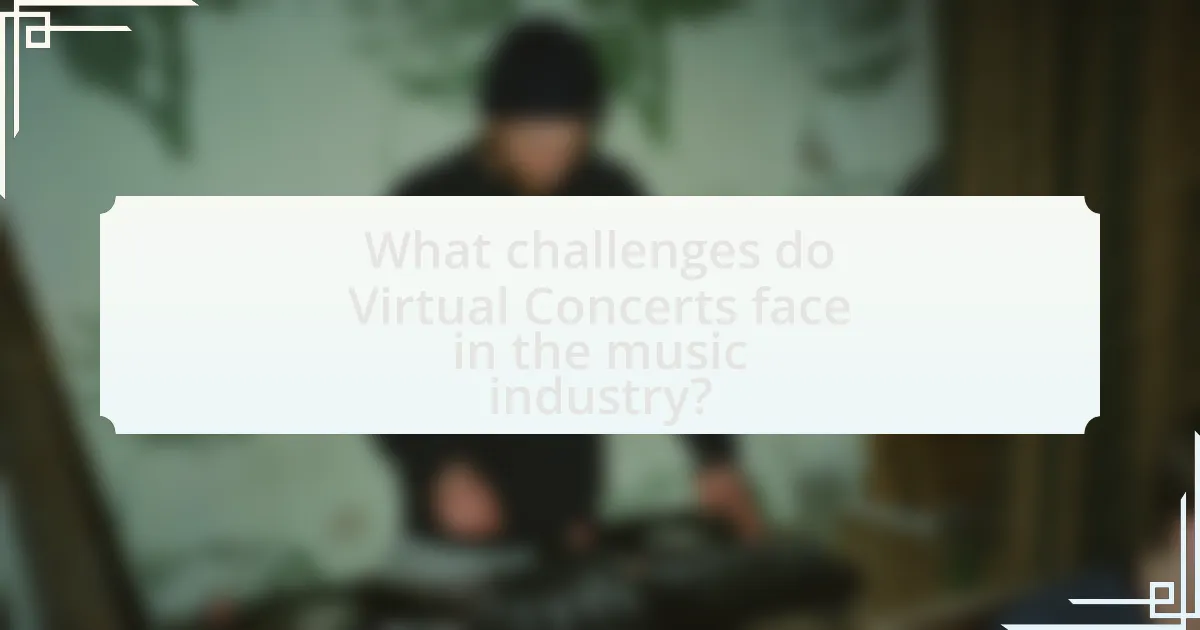
What challenges do Virtual Concerts face in the music industry?
Virtual concerts face several challenges in the music industry, including technical issues, audience engagement, and monetization difficulties. Technical issues often arise from internet connectivity problems, which can disrupt the streaming experience and lead to viewer dissatisfaction. Audience engagement is another significant challenge, as virtual formats lack the physical presence and energy of live performances, making it harder for artists to connect with fans. Additionally, monetization remains a hurdle, as artists and promoters struggle to generate revenue comparable to traditional concerts, with many relying on ticket sales, merchandise, and sponsorships that may not yield sufficient income. These challenges highlight the complexities of adapting to a digital concert landscape while maintaining the essence of live music experiences.
What are the technical challenges associated with hosting Virtual Concerts?
The technical challenges associated with hosting virtual concerts include bandwidth limitations, latency issues, and the need for high-quality audio and video production. Bandwidth limitations can lead to buffering and poor streaming quality, affecting the audience’s experience. Latency issues can cause delays between the performance and audience interaction, disrupting real-time engagement. Additionally, high-quality audio and video production requires advanced equipment and skilled personnel to ensure a professional presentation, which can be costly and logistically complex. These challenges must be addressed to deliver a seamless virtual concert experience.
How do issues of sound quality and connectivity affect the experience?
Issues of sound quality and connectivity significantly diminish the overall experience of virtual concerts. Poor sound quality can lead to distorted audio, making it difficult for attendees to appreciate the music, while connectivity issues can result in interruptions or delays, disrupting the flow of the performance. Research indicates that 70% of virtual concert attendees report that sound quality directly impacts their enjoyment, highlighting the importance of clear audio for an immersive experience. Additionally, studies show that 60% of users experience frustration due to connectivity problems, which can lead to disengagement from the event. Thus, both sound quality and connectivity are critical factors that shape the audience’s enjoyment and engagement during virtual concerts.
What security concerns arise during Virtual Concerts?
Security concerns during virtual concerts include data privacy, unauthorized access, and cyberattacks. Data privacy issues arise as personal information of attendees can be exposed during registration and streaming. Unauthorized access can occur if event platforms are not secured, allowing intruders to disrupt the concert or steal sensitive data. Cyberattacks, such as Distributed Denial of Service (DDoS) attacks, can overwhelm servers, leading to service outages and a poor experience for attendees. According to a report by Cybersecurity Ventures, cybercrime is projected to cost the world $10.5 trillion annually by 2025, highlighting the increasing risks associated with online events.
How do artists monetize Virtual Concerts?
Artists monetize virtual concerts primarily through ticket sales, merchandise sales, and sponsorships. Ticket sales generate direct revenue, with platforms like Veeps and Stageit allowing artists to set prices for access to their performances. Merchandise sales during virtual events can significantly boost income, as artists often promote exclusive items to their audience. Additionally, sponsorships from brands seeking to reach the artist’s fanbase provide another revenue stream, with companies often paying for promotional placements during the concert. According to a report by Pollstar, virtual concerts generated over $100 million in ticket sales in 2020, highlighting the financial viability of this model for artists.
What are the different revenue models for Virtual Concerts?
The different revenue models for virtual concerts include ticket sales, sponsorships, merchandise sales, and subscription services. Ticket sales generate direct income from attendees purchasing access to the concert, often through platforms like Eventbrite or specialized streaming services. Sponsorships involve brands paying to promote their products during the concert, leveraging the audience’s attention for marketing purposes. Merchandise sales allow artists to sell branded items directly to fans during or after the event, enhancing revenue. Subscription services, such as Patreon or Twitch, provide ongoing support from fans in exchange for exclusive content, including virtual concerts. These models have been validated by the increasing popularity of platforms like Twitch, which reported a 50% increase in revenue from subscriptions and sponsorships in 2020, highlighting the effectiveness of these revenue streams in the virtual concert space.
How do ticket sales and merchandise play a role in monetization?
Ticket sales and merchandise are crucial components of monetization in the context of virtual concerts, as they directly generate revenue for artists and event organizers. Virtual concerts have expanded the audience reach, allowing artists to sell tickets to fans worldwide, which can significantly increase overall ticket sales compared to traditional live events. For instance, a study by Eventbrite indicated that virtual events can attract up to 10 times more attendees than in-person concerts, leading to higher ticket revenue. Additionally, merchandise sales during virtual concerts enhance monetization by providing fans with exclusive products, often tied to the event, which can lead to increased sales. According to a report by Nielsen Music, merchandise sales can account for up to 30% of an artist’s total revenue, emphasizing the importance of both ticket sales and merchandise in the overall monetization strategy for virtual concerts.
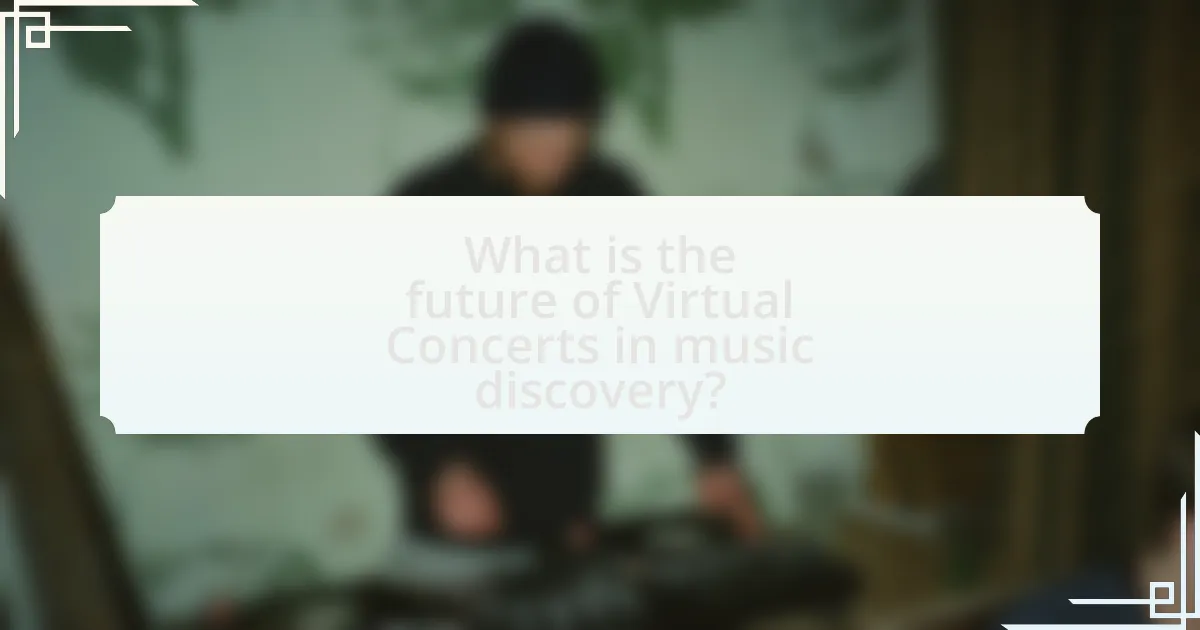
What is the future of Virtual Concerts in music discovery?
The future of virtual concerts in music discovery is poised for significant growth, driven by advancements in technology and changing consumer behaviors. Virtual concerts provide artists with a global platform to reach diverse audiences, facilitating the discovery of new music across geographical boundaries. According to a report by Eventbrite, 70% of attendees at virtual events are more likely to discover new artists compared to traditional concerts, highlighting the effectiveness of these platforms in promoting emerging talent. As virtual reality and augmented reality technologies evolve, they will enhance the immersive experience of virtual concerts, further engaging audiences and fostering deeper connections with artists. This evolution will likely lead to an increase in collaborations between artists and tech companies, creating innovative ways for fans to discover and interact with music.
How might technology evolve to enhance Virtual Concert experiences?
Technology will evolve to enhance virtual concert experiences through advancements in immersive technologies, such as virtual reality (VR) and augmented reality (AR). These technologies will enable users to experience concerts as if they were physically present, providing 360-degree views and interactive elements that engage audiences more deeply. For instance, VR platforms like Oculus have already demonstrated the potential for fully immersive environments where users can interact with other concert-goers and the performers in real-time. Additionally, improvements in streaming quality, such as 8K resolution and spatial audio, will further enhance the realism of virtual concerts, making them more appealing to audiences. According to a report by Statista, the global virtual reality market is projected to reach $57.55 billion by 2027, indicating a significant investment in technologies that can transform entertainment experiences, including virtual concerts.
What innovations are on the horizon for Virtual Concerts?
Innovations on the horizon for virtual concerts include enhanced immersive experiences through augmented reality (AR) and virtual reality (VR) technologies. These advancements aim to create more engaging environments that replicate the atmosphere of live performances, allowing audiences to interact with the concert in real-time. For instance, platforms like Wave and Oculus Venues are already experimenting with these technologies, enabling users to attend concerts from the comfort of their homes while feeling as if they are part of a live audience. Additionally, the integration of artificial intelligence (AI) for personalized content delivery and audience interaction is expected to revolutionize how fans experience music events, tailoring performances to individual preferences. This shift is supported by the growing trend of digital engagement in the music industry, as evidenced by the significant increase in virtual concert attendance during the COVID-19 pandemic, which saw platforms like Fortnite host concerts that attracted millions of viewers.
How could Virtual Concerts reshape the music industry landscape?
Virtual concerts could reshape the music industry landscape by providing artists with new revenue streams and expanding their audience reach. These online events eliminate geographical barriers, allowing fans from around the world to attend performances without the costs associated with travel and accommodation. For instance, during the COVID-19 pandemic, platforms like Twitch and YouTube saw a significant increase in virtual concert attendance, with some artists reporting millions of viewers for single events. This shift not only democratizes access to live music but also enables artists to monetize their performances through ticket sales, merchandise, and sponsorships, thereby transforming traditional concert economics.
What best practices should artists follow for successful Virtual Concerts?
Artists should prioritize high-quality audio and video production for successful virtual concerts. Ensuring clear sound and visually appealing visuals enhances audience engagement and satisfaction. According to a survey by Eventbrite, 70% of attendees rated audio quality as the most important factor in their virtual concert experience. Additionally, artists should actively promote their events across social media platforms and engage with fans before, during, and after the concert to build a community and increase attendance. Research from the International Journal of Arts Management indicates that effective marketing strategies can significantly boost audience turnout for online events. Finally, incorporating interactive elements, such as live Q&A sessions or polls, can enhance viewer participation and create a more immersive experience, as evidenced by successful virtual concerts that have utilized these features to maintain audience interest.
How can artists effectively promote their Virtual Concerts?
Artists can effectively promote their virtual concerts by leveraging social media platforms, engaging with their fanbase, and utilizing targeted advertising. Social media platforms like Instagram, Facebook, and TikTok allow artists to share promotional content, behind-the-scenes footage, and live interactions, which can significantly increase audience engagement. According to a study by Eventbrite, 62% of event creators use social media to promote their events, highlighting its effectiveness in reaching potential attendees. Additionally, artists can collaborate with influencers or other musicians to expand their reach, as partnerships can introduce their concerts to new audiences. Targeted advertising on platforms like Facebook and Google can also help artists reach specific demographics, ensuring that promotional efforts are directed toward individuals most likely to attend.
What strategies can enhance audience engagement during Virtual Concerts?
Interactive features such as live chat, polls, and Q&A sessions can significantly enhance audience engagement during virtual concerts. These elements allow viewers to participate actively, fostering a sense of community and connection with the performers. For instance, a study by Eventbrite found that 70% of attendees felt more engaged when they could interact with artists and other fans in real-time. Additionally, incorporating gamification elements, such as rewards for participation or exclusive content for active viewers, can further motivate audience involvement. By utilizing these strategies, virtual concerts can create a more immersive and engaging experience for attendees.
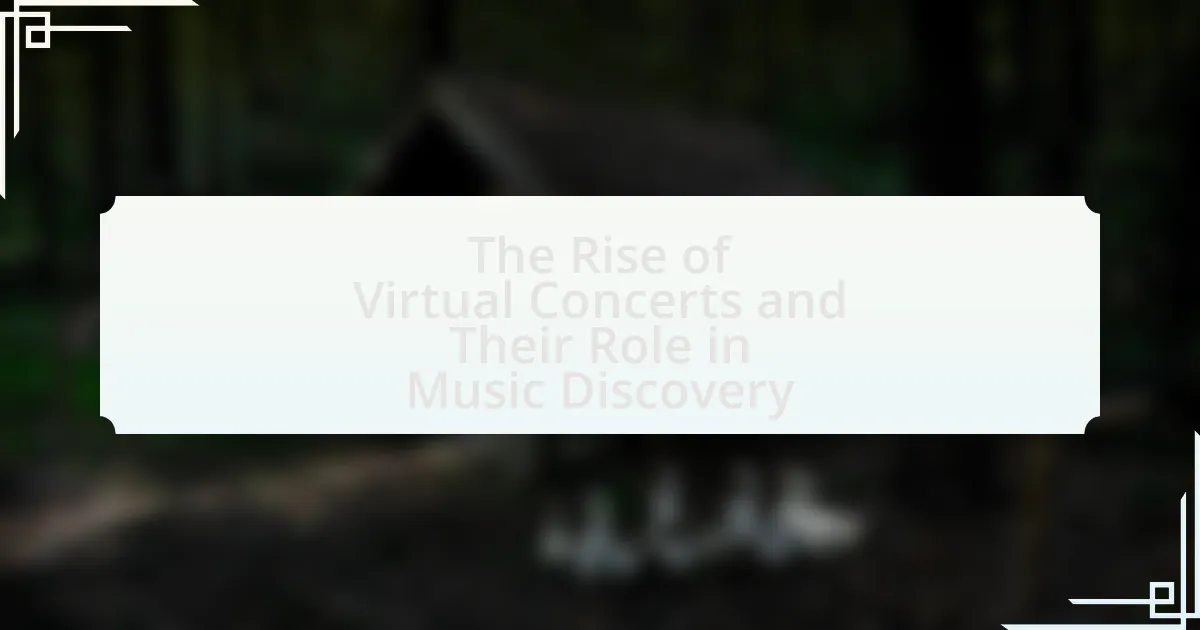
Leave a Reply